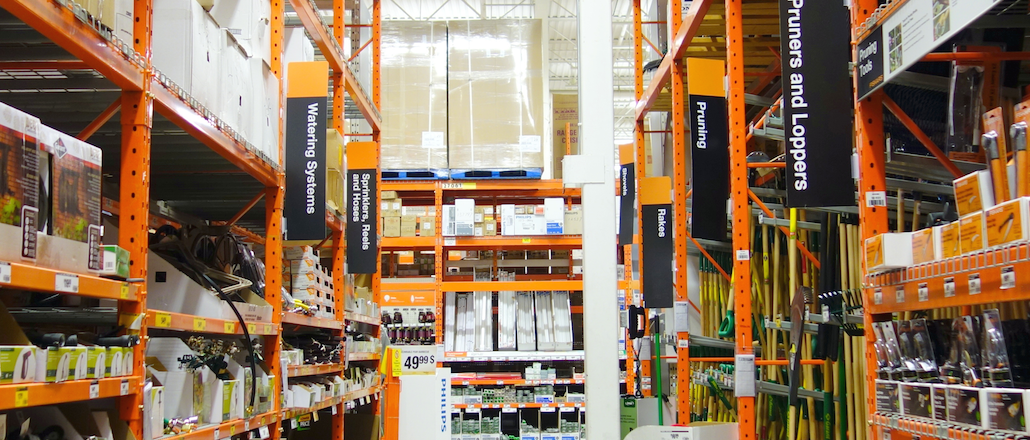
Thanks to a bounce-back in the housing market over the past several years, the home improvement industry has been rejuvenated as well. With rebounding sales, the country’s biggest home store chains — Home Depot and Lowe’s — are both working to digitize the experience for the 2015 consumer.
Out of the gates, Lowe’s is the underdog. The company is smaller in numbers and sales — and ranked 10th, behind Home Depot, on this year’s BrandZ list of most valuable retail brands. Home Depot came in fourth. BrandZ’s curators, Millward Brown and WPP, valued Home Depot at $27.7 billion and Lowe’s at $10.7 billion when taking brand sentiment and revenue into consideration.
To make shopping seamless, both brands are focusing on their omnichannel strategies to blend a cohesive on-to-offline experience for consumers and ultimately drive sales. So far, here’s how the strategies stack up.
Project innovation
Sean Bartlett, Lowe’s director of digital experience and product, said the company’s omnichannel strategy boils down to one principle for customer executing projects: to never have to start over. To make that possible, associates are equipped with a program that records notes on the progress of a project that can then be sent to the customer’s phone during any decision making.
Lowe’s is also using new technologies to help address the problems that customers face. Lowe’s Innovation Labs, launched in 2014, are dedicated to such development. So far, the company has tested out “Holorooms,” augmented reality showrooms that let customers design an ideal bathroom and visualize what the outcome would look like in real life.
Ad position: web_incontent_pos1
The Labs have also employed a customer service robot, meant to facilitate faster in-store assistance, and most recently, 3D printing capabilities, which can customize or scan pieces and print them on site — perfect for getting the just-right color shade or replacing tricky-to-find parts.
Home Depot, meanwhile, has grown its services to offer solutions for two types of customers: those who are DIY (d0-it-yourself) and DIFM (do-it-for-me). When customers visit HomeDepot.com with a project in mind, the company will provide the tools, timeline and steps for the person who wants to be hands on. For those who don’t, they can easily recruit one of Home Depot’s licensed contractors online. Kevin Hofmann, Home Depot’s senior vp of online, added that tens of thousands of conversations happen with associates via online chat and phone every day.
Ad position: web_incontent_pos2
“We believe that’s a part of the secret sauce: the ‘product authority’ that what we bring to the table,” he said.
Winner: Lowe’s. While Home Depot can reliably help you get your project done, or get it done for you, Lowe’s pulls ahead in innovation — and according to Barlett, the innovation team is dedicated to making sure the technology is functional, not distracting.
In-store navigation
Home-improvement stores are physically huge, making them ripe for digital enhancements.
Both stores use mobile as the shopper’s companion as they navigate the store. Lowe’s offers free Wi-Fi to enable easier connections, and on its mobile app, the company has rolled out store maps, shopping lists and location-based product inventory that updates in real time.
Home Depot’s mobile app has all of those functions and then some. The app offers an opt-in location service for shoppers so that as they browse, the inventory for the aisle they’re in pops up. While they look at what’s in front of them, what’s additionally available online will appear on their phones.
Home Depot’s app also enables voice commands that respond to general and specific commands to guide the customer to where they can find it in store. But Hofmann recognized that not everyone who shops at Home Depot is going to go to the trouble of downloading the app, so he said efforts are funneled into enhancing Home Depot’s mobile webpage, making sure that the online component complements the in-store, and vice versa.
Winner: Home Depot. Both companies understand that, since it’s in customers’ pockets, mobile is key to in-store navigation, but Home Depot’s understanding that not everyone’s going to download the app gives it an extra boost.
Social media
Lowe’s may have fewer stores than Home Depot, but it’s got a bigger social media footprint.
On YouTube, where both companies post how-to videos for home DIY projects, Lowe’s has 155,000 followers compared to Home Depot’s 89,000. On Pinterest, although the companies have the same number of boards (covering similar topics like “Gardening” and “Patio Style”), Lowe’s follower count squashes Home Depot’s with 3 million compared to 300,000.
And on Vine, Lowe’s #FixinSix series, which Bartlett said holds a “wealth of information,” has raked in 39 million overall loops, compared to Home Depot’s 7 million.
Winner: Facebook, Twitter and Instagram followings are neck and neck for both brands, and both use shopping platform Like2Buy to facilitate purchases, but Lowe’s major followings on Vine, Pinterest and YouTube give the company major social cred.
More in Marketing

In the marketing world, anime is following in the footsteps of gaming
As marketers look to take advantage of anime’s entry into the zeitgeist, they might be wise to observe the parallels between the evolution of anime as a marketing channel and the ways brands have learned to better leverage gaming in recent years.

With the introduction of video ads and e-commerce, Roblox looks to attain platform status
Roblox is expanding into more areas than just ads in 2024. Much like platforms such as Amazon and Facebook have transcended their origins to evolve from their origins as online marketplaces and social media channels, Roblox is in the midst of a transformation into a platform for all elements of users’ virtual lives.

PepsiCo wants to remain a ‘driver of culture’ as it turns to influencers and activations amid rebrand
The soda-maker says it can translate cultural relevance into sales volume.
Ad position: web_bfu